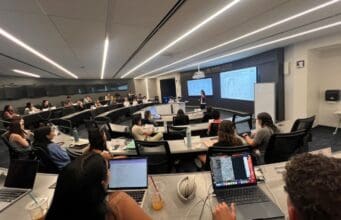Using rigorous methodologies, Goizueta faculty focus on researching important problems that affect the practice of business. The following is a sample of recently created new knowledge. To learn more, please visit goizueta.emory.edu/faculty.
Securitized loan modification and loan performance
 After the collapse of the housing market, the wave of foreclosures in the US changed the economic landscape of many neighborhoods across the country. Some academics and policymakers have argued that the renegotiation of those loans was a much better alternative than foreclosure and that incentives should have been offered to financial institutions to encourage it. However, little research exists to understand the performance of loans that were modified. Gonzalo Maturana, assistant professor of finance, takes a close look at loan modifications made early in the recent housing crisis to better understand the value of offering incentives to modify securitized non-agency loans. According to Maturana, researchers contend that the small number of loan modifications added to the number of foreclosures during the subprime crisis. His analysis consisted of slightly more than 835,000 non-agency securitized loans that became delinquent between August 2007 and February 2009. Maturana found that loan “modification reduces loan losses by 35.8% relative to the average loss, which suggests that the marginal benefit of modification likely exceeded the marginal cost.” Additionally, modifications resulted in fewer liquidations. He also found that modifications were particularly useful “in preventing future loan losses in times of large increases in delinquencies when servicers are more likely to be working at full capacity.” Review of Financial Studies (2017)
After the collapse of the housing market, the wave of foreclosures in the US changed the economic landscape of many neighborhoods across the country. Some academics and policymakers have argued that the renegotiation of those loans was a much better alternative than foreclosure and that incentives should have been offered to financial institutions to encourage it. However, little research exists to understand the performance of loans that were modified. Gonzalo Maturana, assistant professor of finance, takes a close look at loan modifications made early in the recent housing crisis to better understand the value of offering incentives to modify securitized non-agency loans. According to Maturana, researchers contend that the small number of loan modifications added to the number of foreclosures during the subprime crisis. His analysis consisted of slightly more than 835,000 non-agency securitized loans that became delinquent between August 2007 and February 2009. Maturana found that loan “modification reduces loan losses by 35.8% relative to the average loss, which suggests that the marginal benefit of modification likely exceeded the marginal cost.” Additionally, modifications resulted in fewer liquidations. He also found that modifications were particularly useful “in preventing future loan losses in times of large increases in delinquencies when servicers are more likely to be working at full capacity.” Review of Financial Studies (2017)
The rise of ETFs and market impact

As the popularity of exchange-traded funds (ETFs) continues to grow at a rapid pace, the role that these basket or index-linked products play in the market is an ever-growing concern. For instance, ETFs now constitute more than 30% of the daily value traded in US exchanges. Suhas A. Sridharan, assistant professor of accounting, and coauthors Doron Israeli (Interdisciplinary Center Herzliya) and Charles M. C. Lee (Stanford U) dive into the issue by examining the impact of ETF ownership on the availability of information on individual securities and the market for those same securities. The trio analyzes a sample of 443 unique ETFs for the firm-year between 2000 and 2014. They note that ETFs are a particularly attractive investment vehicle for less informed traders. With trading costs for individual securities rising as a result of the flow to ETFs, more informed traders have less of an incentive “to expend resources to obtain firm-specific information.” As the depth and size of the ETF market grows, individual stock prices become less informative. Review of Accounting Studies (2017)
Understanding economic development and its environmental impact

While fears about the environmental impact of economic development remains under discussion, the number of proenvironmental international non-governmental organizations (INGOs) continues to grow. But little is known about their influence on countries to create more eco-friendly industrial processes and technologies. In new research from Wesley Longhofer, assistant professor of organization & management, and coauthor Andrew Jorgenson (Boston College), the pair determined which nations they believed were “more embedded in the proenvironmental world society,” determining the level of influence of INGOs, as well as global treaties and professionals, on the countries they studied. The data took into account GDP per capita to find the effect of economic development on carbon emissions. The research examined whether countries that were more likely to feel this global pressure to “enact pro-environmental policies or invest in cleaner technologies” subsequently experienced a drop in rates of carbon emissions. Longhofer and Jorgenson created a measure to analyze the effects of development over time on carbon emissions in 79 countries, using data from 1970 to 2009. They found that “nations that are the most embedded in the environmental world society experienced a moderate decrease” in the impact of economic development on carbon emissions. Essentially, larger and more developed nations were more likely to feel the influence of proenvironmental INGOs than less developed countries, ultimately showing a small drop in carbon emissions. Social Science Research (2017)
Consumer word-of-mouth and social media
 Certainly, marketers are well aware of the value of the consumers’ word-of-mouth (WOM) endorsements of a product or service. But the ubiquitous nature of social media demands that advertisers find new ways to tap into how consumers interact and communicate to leverage the power of WOM online. Panagiotis Adamopoulos, assistant professor of information systems & operations management; Vilma Todri, assistant professor of information systems & operations management; and Anindya Ghose (NYU-Stern) take a close look at the role of hidden personality traits of online users and how they play into the effectiveness of product WOM on Twitter. The trio used big data, machine learning methods, and causal inference econometric techniques to study consumer purchases made through Twitter accounts. The research showed an increase in the likelihood of a purchase by 47.58% when there was exposure to WOM tweets from a sender who had similar personality traits to the recipient of the information. The trio found that introvert users were much more accepting of WOM versus extrovert users. They also noted agreeable, conscientious, and open social media users are more effective influencers. The combinations of personality traits of disseminators and recipients of WOM impacted the decision to buy a product, with the researchers noting that a “WOM message from an extrovert user to an introvert peer increases the likelihood of a subsequent purchase by 71.28%.” Information Systems Research (2018)
Certainly, marketers are well aware of the value of the consumers’ word-of-mouth (WOM) endorsements of a product or service. But the ubiquitous nature of social media demands that advertisers find new ways to tap into how consumers interact and communicate to leverage the power of WOM online. Panagiotis Adamopoulos, assistant professor of information systems & operations management; Vilma Todri, assistant professor of information systems & operations management; and Anindya Ghose (NYU-Stern) take a close look at the role of hidden personality traits of online users and how they play into the effectiveness of product WOM on Twitter. The trio used big data, machine learning methods, and causal inference econometric techniques to study consumer purchases made through Twitter accounts. The research showed an increase in the likelihood of a purchase by 47.58% when there was exposure to WOM tweets from a sender who had similar personality traits to the recipient of the information. The trio found that introvert users were much more accepting of WOM versus extrovert users. They also noted agreeable, conscientious, and open social media users are more effective influencers. The combinations of personality traits of disseminators and recipients of WOM impacted the decision to buy a product, with the researchers noting that a “WOM message from an extrovert user to an introvert peer increases the likelihood of a subsequent purchase by 71.28%.” Information Systems Research (2018)
Speculation and its impact on trading volume
 Financial researchers have long wondered exactly which economic forces cause variation in asset prices and returns. For instance, traders will often target financial instruments due to their volatile and highly liquid nature, such as US treasury bonds. This speculative behavior takes advantage of the frequent price movements of the product. But the influence of that behavior remains the subject of debate. Francisco Barillas, assistant professor of finance, and Kristoffer Nimark (Cornell U) take a deep dive into the issue by investigating the impact of speculative trading activity on the variation of long maturity US bond yields. For their analysis, Barillas and Nimark use public information to develop a rational model to track “informed traders that take on speculative positions to exploit what they perceive to be inaccurate market expectations about future bond prices.” They argue that their research takes a more “suitable approach for empirical work” by factoring in how traders exploit private information that other traders may not have. The authors note that bond prices alone are not enough information for predicting bond returns. The two write, “If traders have access to different information, this price may differ from what an individual trader would be willing to pay for the bond if he had to hold it until maturity.” Ultimately, they find that this speculation remains a key driver of trading volume, accounting for a “substantial fraction of the variation in historical US bond yields along with the usual analysis of estimating returns based on bond prices.” Review of Financial Studies (2017)
Financial researchers have long wondered exactly which economic forces cause variation in asset prices and returns. For instance, traders will often target financial instruments due to their volatile and highly liquid nature, such as US treasury bonds. This speculative behavior takes advantage of the frequent price movements of the product. But the influence of that behavior remains the subject of debate. Francisco Barillas, assistant professor of finance, and Kristoffer Nimark (Cornell U) take a deep dive into the issue by investigating the impact of speculative trading activity on the variation of long maturity US bond yields. For their analysis, Barillas and Nimark use public information to develop a rational model to track “informed traders that take on speculative positions to exploit what they perceive to be inaccurate market expectations about future bond prices.” They argue that their research takes a more “suitable approach for empirical work” by factoring in how traders exploit private information that other traders may not have. The authors note that bond prices alone are not enough information for predicting bond returns. The two write, “If traders have access to different information, this price may differ from what an individual trader would be willing to pay for the bond if he had to hold it until maturity.” Ultimately, they find that this speculation remains a key driver of trading volume, accounting for a “substantial fraction of the variation in historical US bond yields along with the usual analysis of estimating returns based on bond prices.” Review of Financial Studies (2017)










